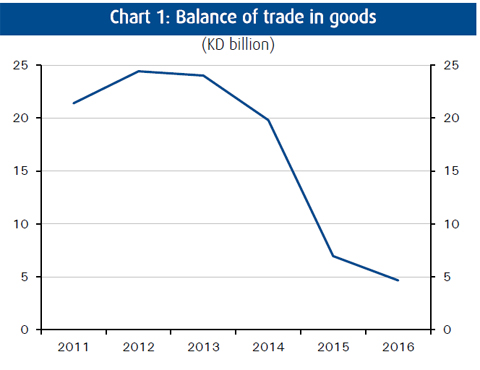 .
.KUWAIT: Kuwait’s trade surplus retreated to an 11-year low of KD 4.7 billion in 2016 or 14 percent of GDP, as oil export earnings remained weak against a backdrop of limited import growth. Oil export revenues continued to be weighed down by lower oil prices, though we expect them to pick up in 2017 amid a sustained recovery in prices.
Meanwhile, imports were flat in 2016, with the weakness mainly stemming from the continued contraction in consumer goods imports. By contrast, growth in imports of capital goods remained healthy, reflecting the strong momentum seen in capital spending and investment. Oil export receipts declined by 14.1 percent in 2016 to KD 12.5 billion, its lowest level in just over a decade. Oil export revenues remained in decline amid a depressed global oil price environment in 2016.
The Kuwait Export Crude (KEC) price was down 18 percent during the year after logging in an annual average of $39 per barrel. However, oil export revenues are expected to recover in the near-to-medium term on the back of a sustained recovery in oil prices. KEC has averaged $52 per barrel during 1Q17 to-date through mid-March, almost double the reading witnessed during the same period last year.
Non-oil exports also fell in 2016 mainly due to markedly lower ethylene prices. Non-oil export earnings, which consist predominantly of ethylene, declined by 17 percent in 2016 on the back of an 11 percent drop in ethylene prices. A stronger Kuwaiti dinar against most major currencies (with the exception of the US dollar) has also dampened growth in non-oil export receipts. However, this segment is expected to recover in the near-to-medium term, as ethylene prices recover; indeed, prices are already up 23 percent y/y through the middle of March.
Import growth was flat in 2016, as healthy gains in imports of capital goods were offset by weakness in consumer goods imports. Consumer goods imports were down 9.0 percent in 2016, on the back of softer consumer demand, particularly in the passenger motor cars component. Imports of passenger motor cars were down by 20 percent in 2016, starkly higher than the 2.5 percent decline witnessed in 2015. By contrast, imports of capital goods (a good gauge of the level of investment in the economy) remained healthy, rising by a strong 10.9 percent in 2016, reflecting a resilient non-oil economy and the government’s improved implementation of its development projects










